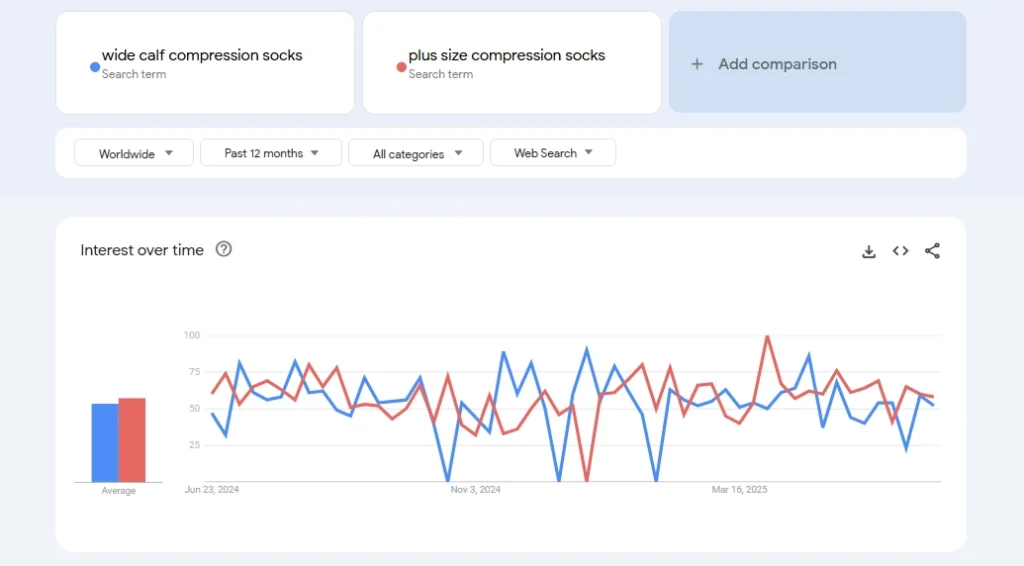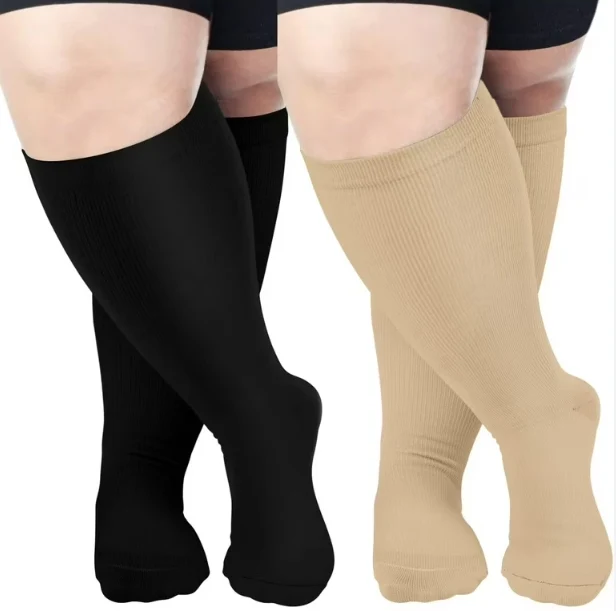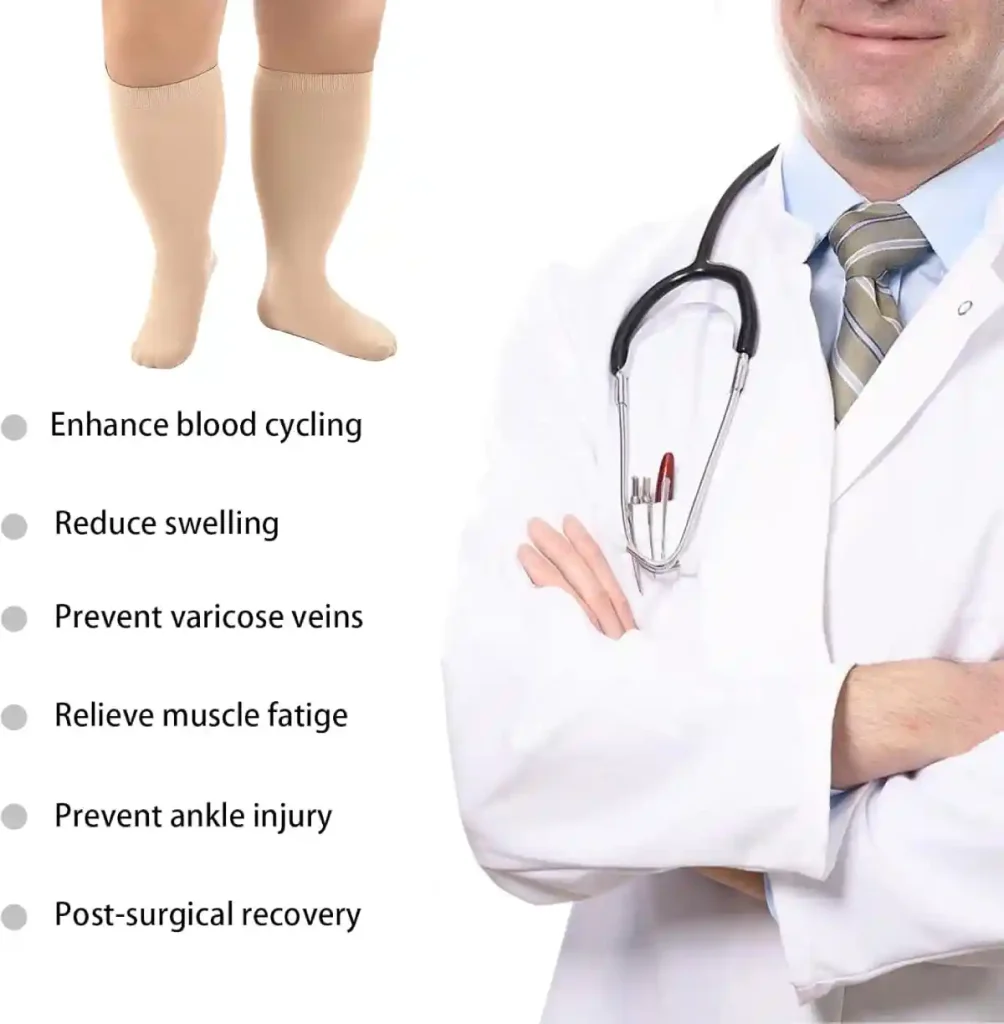Introduction
In the world of hosiery, one size does not fit all. For brands and retailers, overlooking the needs of customers with wider calves means missing out on a significant and loyal market segment. Wide-calf compression socks are not just a niche product; they are a necessity for a large portion of the population that struggles with standard sizing. As a B2B buyer, understanding the technical specifications, benefits, and market demand for this specialized product is crucial for expanding your product line and attracting a broader customer base. This guide, from your trusted manufacturing partner, Max Hosiery, will provide a comprehensive overview to help you meet this growing demand with confidence.

The Sizing Gap: Why Standard Compression Socks Miss the Mark
A common but overlooked challenge in the compression sock market is poor fit for individuals with larger calves. Most standard compression socks are engineered around average leg dimensions, typically capping calf circumference at around 15–17 inches. For users exceeding this range, compression socks can quickly shift from therapeutic to problematic.
The issue starts with insufficient stretch and tapering in the calf section and upper cuff. When these components fail to accommodate a wider calf, several problems arise. The sock may dig into the skin, roll down during activity, or create an uncomfortable squeezing sensation near the knee. This not only causes discomfort but also defeats the purpose of graduated compression by disrupting proper pressure distribution along the leg.
An ill-fitting compression sock offers uneven pressure, often concentrating force around the cuff while providing inadequate compression at the ankle and mid-calf. This imbalance undermines circulation support, reduces swelling control, and causes early fatigue in wearers. In some cases, it can even leave marks or bruising, resulting in customer dissatisfaction.
From a business standpoint, these frustrations lead to product returns, poor reviews, and reduced long-term compliance—especially in medical, wellness, and plus-size retail markets. Wide-calf compression socks solve this issue by offering enhanced elasticity, precise sizing options, and anatomical shaping that better matches leg contours. For brands aiming to serve underserved demographics or expand into inclusive product lines, these socks present a valuable opportunity to meet unmet demand while improving customer retention.
The Solution: Defining and Designing Wide-Calf Compression Socks
The Solution: Redesigning for Wider Calves
Wide-calf compression socks are not a simple size-up—they are structurally redesigned to meet both anatomical and therapeutic needs. For brands serving plus-size customers, hospitals, or wellness chains, this product category fills a real demand gap.
Expanded Diameter for Calf Comfort
These socks are engineered with a wider circumference through the calf and cuff, often using a higher percentage of spandex or stretch nylon. This allows the socks to accommodate calves up to 25 inches (63.5 cm) without deforming the compression profile. Specialized knitting methods provide flexibility where needed without compromising integrity.
Non-Binding, Stay-Up Design
One common issue with standard compression socks is tightness at the cuff. In contrast, wide-calf socks feature a soft, elastic top band that holds without cutting into the skin. This ensures all-day comfort and minimizes “muffin top” bulges that customers often complain about.
Consistent Graduated Compression
Despite the increased stretch, these socks still offer true graduated compression, applying more pressure at the ankle and easing up the leg. This structure supports venous return, reduces swelling, and improves muscle oxygenation—crucial benefits for recovery, travel, or prolonged standing.
For B2B buyers, offering wide-calf options supports inclusive sizing and helps brands position themselves as responsive, consumer-focused, and medically aligned. It’s not just good design—it’s good business.
How Graduated Compression Enhances Wide-Calf Sock Performance
A well-designed wide-calf compression sock is not just about extra width—it must also deliver graduated compression, the gold standard in circulatory support. This medical-grade structure ensures the firmest pressure at the ankle (typically 20–30 mmHg), gradually decreasing to around 10–15 mmHg near the knee. This tapering effect is essential for promoting upward blood flow, aiding the veins in returning blood to the heart.
This targeted pressure gradient offers more than just comfort. For users with wider calves—whether due to genetics, weight, or muscular build—standard compression socks often fail to apply consistent pressure, reducing therapeutic effect. A properly engineered wide-calf version maintains the correct gradient without cutting into the skin or slipping down, making it suitable for both medical and everyday use.
Key physiological benefits include:
- Boosted circulation: Helps reduce fatigue, especially for workers who stand all day or travelers on long flights.
- Swelling prevention: Reduces fluid accumulation from inactivity or vascular conditions.
- Support during movement: Limits muscle oscillation during walking or light exercise, which can improve endurance and recovery.
- Proactive vein care: Offers relief for early signs of varicose veins, edema, or DVT risk.
For brands targeting wellness, travel, maternity, or plus-size markets, offering compression socks tailored to wide calves opens doors to underserved but high-potential customer groups. Medical-grade function combined with inclusive fit delivers measurable product value that resonates with modern, health-conscious consumers.
Fabric Innovation Drives Fit and Comfort
When it comes to wide-calf compression socks, material selection plays a central role in determining how well the product performs across comfort, durability, and function. A truly well-made compression sock doesn’t just stretch—it stretches intelligently, offering the right pressure while adapting to different calf widths.

To achieve this, manufacturers often rely on a calculated blend of high-stretch fibers, most commonly a mix of nylon, spandex, and often polyester or cotton. Spandex, known for its elasticity, is the key to a supportive yet forgiving fit. A higher spandex ratio in the calf and cuff zones ensures the sock stays in place while delivering consistent graduated compression—crucial for wearers with broader calves.
Nylon contributes structure and toughness, maintaining the sock’s shape after repeated wear and wash. More importantly, it supports moisture-wicking, preventing sweat buildup. This feature is enhanced when polyester is included, helping draw moisture away from the skin and creating a dry, irritation-free environment. Many buyers in healthcare, workplace, and travel segments specifically seek out this property for long-term wear.
Premium yarns may also come with anti-microbial or anti-odor finishes, adding hygienic value—an increasingly important feature in customer satisfaction and product differentiation.
For B2B clients, selecting a manufacturer with proven expertise in performance yarn engineering can be the difference between standard socks and standout products. Partnering with suppliers who understand both the science and end-user needs helps build durable, high-retention product lines.
Sizing Strategy: Why Fit Accuracy Matters
For brands targeting the wide-calf compression sock market, correct sizing isn’t optional—it’s essential. Ill-fitting compression socks not only reduce performance but can lead to discomfort, poor circulation, and higher return rates. For B2B buyers, these risks translate into lost trust, excess logistics costs, and negative reviews.
The Two Key Measurements You Must Include
Unlike standard socks based on shoe size, compression socks require two measurements for a proper fit:
- Ankle circumference at the narrowest point above the ankle bone
- Calf circumference at the widest part of the leg
These two data points determine the correct sock size and ensure effective compression without restriction or slippage.
Offer Full Coverage with Size and Compression Range
To support retail success, we recommend offering a broad size range from S to XXL, accommodating a diverse customer base including athletes, seniors, and plus-size consumers. We also help brands define appropriate compression levels (e.g., 15–20 mmHg for daily use, 20–30 mmHg for medical-grade support).
We can supply you with ready-to-use size guides, packaging tips, and visuals for online and offline use. Including these in your product pages or labels reduces confusion and builds credibility.
Optimize Ordering with Strategic Size Distribution
For wholesale customers, we also assist in recommending size breakdown ratios based on demand data. This ensures your inventory aligns with real-world needs and minimizes unsold stock or product returns.
| Sizing Element | Purpose | B2B Benefit |
|---|---|---|
| Ankle Circumference | Core fit accuracy | Prevents misfitting and complaints |
| Calf Circumference | Ensures correct compression | Boosts comfort and performance |
| Multiple Size Options | Covers a broader demographic | Increases sell-through rates |
| Compression Variants | Meets varied user needs | Appeals to clinical & sports buyers |
| Clear Size Charts | Simplifies ordering and reduces errors | Enhances customer satisfaction |
Expanding Use Cases: Where Wide-Calf Compression Socks Deliver Value
Wide-calf compression socks have moved far beyond their original medical niche. Today, they address real-world needs across various industries, particularly for those underserved by standard sizes. Their wider fit, coupled with graduated compression, allows more individuals to benefit from circulation support—without discomfort or sizing issues. This opens opportunities for brands to diversify offerings and reach untapped market segments.
Workplace Demands in Size-Inclusive Sectors
Many jobs require long hours of standing or sitting, and wide-calf options have become essential for hospitality, healthcare, and warehouse workers who need compression but can’t find regular socks that fit comfortably. In particular, plus-size professionals are often left out of performance gear—offering compression socks designed specifically for broader legs is both inclusive and commercially smart.
Sports and Wellness
Compression gear is often marketed to athletes, but plus-size athletes and recreational fitness users are rarely considered. Offering wide-calf designs tailored for gym-goers, runners, and walkers provides comfort without pinching or rolling. Brands can also cater to growing interest in inclusive activewear with compression features that enhance post-workout recovery.
Comfort Travel and Lifestyle Integration
During long-haul travel or pregnancy, compression socks help manage swelling and reduce fatigue. However, discomfort from tight socks discourages wear. A properly engineered wide-calf fit supports comfort compliance—ideal for travel accessory shops, maternity brands, or lifestyle e-commerce platforms.
Highlighting these differentiated use cases shows B2B clients how wide-calf compression socks go beyond basic function. They solve real problems in underserved markets and align with size-inclusive, wellness-focused product trends.
Aesthetic Appeal: Style and Customization for Your Brand
Historically, compression socks were purely functional and lacked aesthetic appeal. Today’s consumers, however, demand products that combine utility with style. For B2B brands, this presents a significant opportunity for customization and branding.
At Max Hosiery, we understand that style sells. We offer a wide range of customization options to help you build a unique product line that stands out on the shelves:
- Colorways: Choose from a wide palette of colors, from classic neutrals to vibrant, eye-catching hues.
- Patterns and Designs: Incorporate stripes, argyle, or other patterns to appeal to fashion-conscious customers.
- Branding: We can knit or embroider your logo directly onto the sock, making it a powerful marketing tool.
- Packaging: Custom packaging, including boxes, labels, and hang tags, can enhance your brand’s premium image.
- Sizing and Labeling: We can create custom size labels and packaging that clearly communicate the wide-calf fit, building customer confidence and reducing returns.
By offering visually appealing products that also provide exceptional function, you can capture a larger market share and turn a medical necessity into a desirable fashion accessory. This fusion of style and substance is key to success in the modern retail landscape.
Manufacturing Excellence: Our Process and Quality Control
As a B2B buyer, you need a manufacturing partner you can trust. At Max Hosiery, our commitment to excellence is reflected in our robust manufacturing process and strict quality control standards. We utilize state-of-the-art knitting machines capable of producing socks with a wider circumference and consistent graduated compression.
Our process includes:
- Yarn Sourcing: We source high-quality, stretch-friendly yarns from certified suppliers.
- Precision Knitting: Our machines are programmed to create a precise pressure gradient and expanded calf circumference according to your specifications.
- Manual Inspection: Each sock is manually inspected for defects, loose threads, and inconsistencies.
- Compression Testing: We use specialized equipment to test the mmHg compression levels at different points on the sock to ensure it meets the specified standard.
- Durability and Stretch Tests: We perform rigorous tests to ensure the sock maintains its stretch and compression over time and through multiple washes.
This meticulous process ensures that every sock leaving our factory, whether a standard or wide-calf size, is of the highest quality. Partnering with Max Hosiery means you can offer your customers a reliable, high-performance product that lives up to its promises, protecting your brand’s reputation and ensuring customer loyalty.
Market Opportunity: Sizing Up the Wide-Calf Segment
Wide-calf compression socks represent a fast-growing niche that remains largely untapped. Brands that develop specialized offerings for this group can secure loyal customers and command premium pricing. Demand stems from four main segments: individuals with fuller calves seeking everyday support, athletes whose muscle development outstrips standard sizing, patients managing edema or lymphedema, and expectant mothers needing gentle leg compression. Each group shares a need for socks that combine reliable pressure profiles with generous calf room.
Understanding Diverse Customer Needs
Every segment prioritizes different features. Athletes look for breathable, moisture-wicking fabrics and targeted compression that aids recovery without chafing. Medical users require precise 20–30 mmHg pressure ratings and easy donning solutions, such as integrated zippers or silicone top bands. Plus-size shoppers value a broad size range with extended calf girths up to 24 inches. Pregnancy lines benefit from graduated compression levels under 20 mmHg to improve circulation without restricting blood flow.
Building a Specialized Product Line
Launching a dedicated wide-calf collection starts with clear size charts and intuitive fit guides. Position the line with an inclusive brand narrative that highlights your commitment to comfort and health. Invest in fabric blends that pair merino wool or nylon with spandex for both resilience and stretch. Emphasize durable stitching, seamless toe closures, and reinforced heels in product descriptions to showcase quality.
Strategic Partnerships for Growth
Collaborations amplify market reach. Partner with vascular clinics, maternity centers, and sports rehabilitation facilities to endorse your socks. Co-develop co-branded samples with fitness trainers who understand muscle recovery needs. Use these alliances to generate case studies demonstrating real-world benefits, which in turn bolster SEO through authoritative backlinks and keyword-rich content.
By tailoring compression solutions to wide-calf requirements, your brand can become the preferred supplier for retailers, medical distributors, and e-commerce platforms seeking to serve this evolving market.
Conclusion
The wide-calf compression sock market offers brands and retailers a strategic growth avenue. Meeting the needs of athletes, medical patients, and plus-size consumers requires mastery of fit, pressure standards, and high-performance materials. By focusing on accurate sizing charts, durable fabric blends, and thoughtful design features—like seamless toes and reinforced heels—you position your line for success in this underserved segment.

Max Hosiery combines advanced manufacturing, strict quality control, and full customization to deliver reliable wide-calf solutions. Whether you need graduated 20–30 mmHg compression, extended calf girths, or branded colorways, we have the expertise to bring your vision to market.
Contact Max Hosiery today to request samples, discuss bulk customization, or learn how our wide-calf compression socks can strengthen your product portfolio.
FAQ
1. What is the maximum calf circumference your wide-calf socks can accommodate?
Our wide-calf compression socks are engineered to comfortably fit calf circumferences up to 25 inches (63.5 cm), with a top band designed to stay up without constricting.
2. What compression levels do you offer for wide-calf socks?
We offer various graduated compression levels, including 15-20 mmHg for everyday wear and travel, and 20-30 mmHg for athletic performance and medical needs.
3. What is the minimum order quantity (MOQ) for custom designs?
Our MOQs vary based on the level of customization and sock style. Please contact our sales team with your design specifics for a detailed quote and MOQ information.
4. How do your socks ensure a consistent fit and compression for wide calves?
We use a special knitting technique and a high-spandex content in the calf area to ensure even stretch and consistent graduated compression across a wider circumference.
5. Can you add custom branding and logos to the wide-calf socks?
Yes, we offer a range of customization options including jacquard knitting, embroidery, and printing to integrate your logo and brand colors directly onto the socks.
